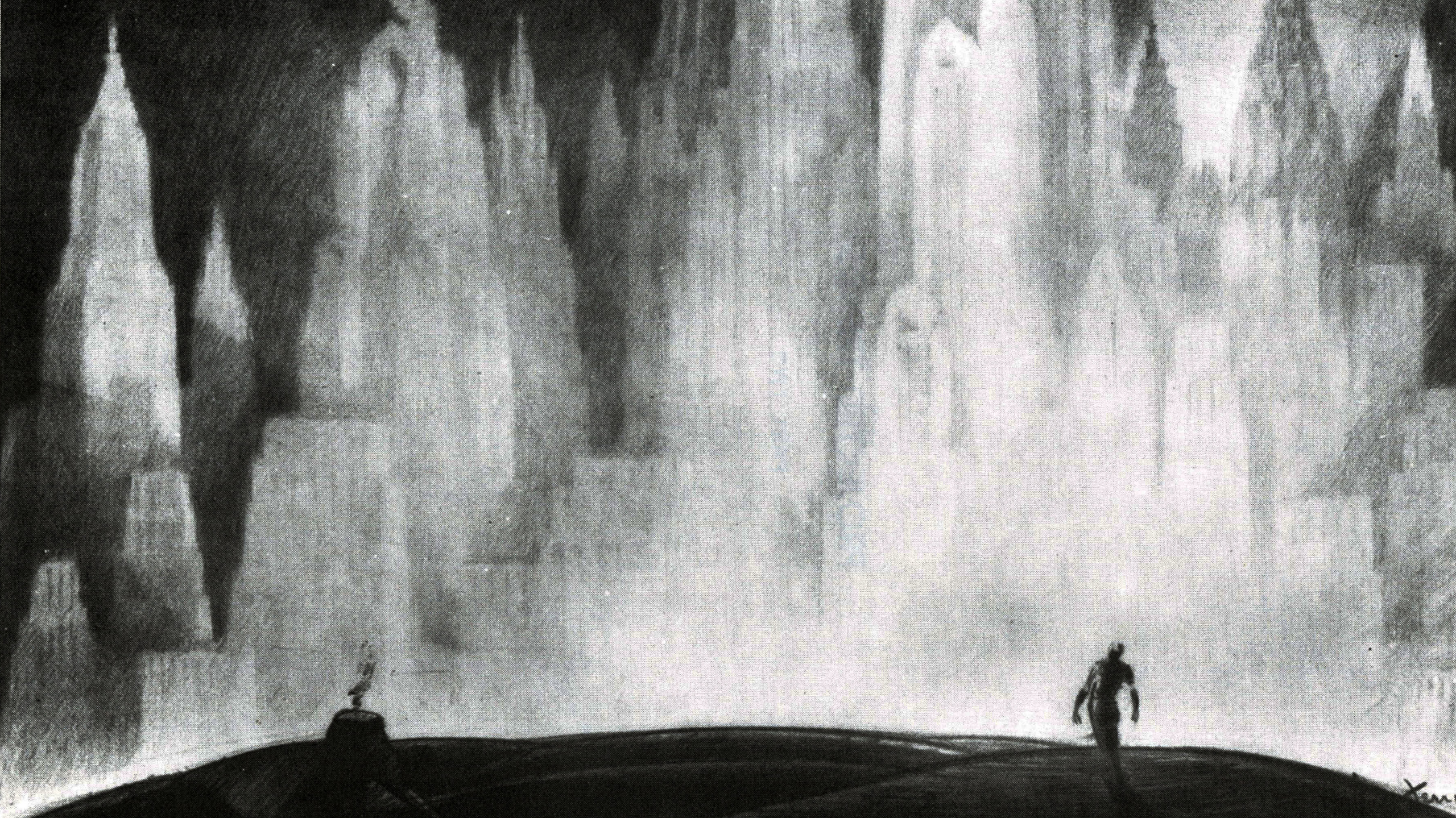
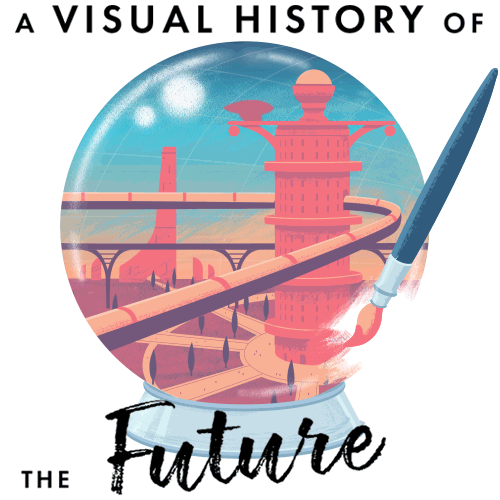
Read the next installment: “The Future We Were Promised”
Read the previous installment: “Animating the Future“

In 1960, Buckminster Fuller had an idea to transform New York City: a two-mile-wide geodesic dome over the top of Manhattan. The self-titled “anticipatory design scientist” wanted to cover the city from the East River to the Hudson and from 21st Street to 64th Street. The dome, made with aluminum and shatterproof glass, would “regulate weather and reduce air pollution.” It was an ambitious project, Fuller acknowledged, but, “the cost of snow removal in New York City would pay for the dome in 10 years.”

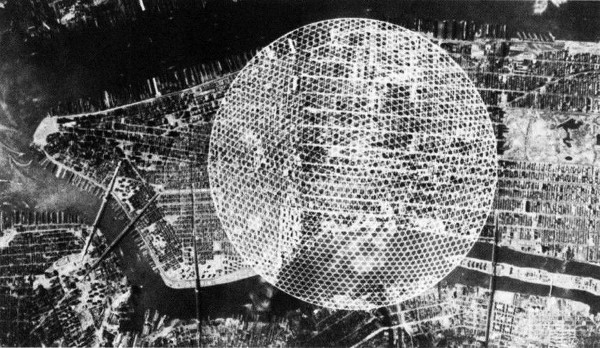
The dome wasn’t Fuller’s only plan for the city of the future. Triton, a two-square-mile tsunami-proof floating city, would provide its 5,000 residents with everything from water to education. It was originally conceived for Tokyo Bay by MatsutarÅ ShÅriki, who sent the proposal to Fuller. In the U.S., it was supported by the Department of Urban Development; and when its “water-worthiness” was signed off by the Navy’s Bureau of Ships, the City of Baltimore proposed it be built in Chesapeake Bay. (The idea was ultimately sunk by bureaucracy.)
For centuries, architects and urban planners have mixed the mundane with the fantastical as they imagined the cities of the future. While some ideas toyed with the building blocks, others reflected a desire to fundamentally reshape urban life–and to solve some of society’s most pressing problems. Their plans were a mix of ambition, realism, fantasy, and folly–but were the resulting ideas visionary, or just dreams of worlds that could never feasibly be built?

As cities grew rapidly in the early modern era, overcrowding, unsafe, and unsanitary conditions led reformers to think about the future shape of urban centers. Some proposals came on the backs of disasters: after the Great Fire of London in 1666, Christopher Wren proposed rebuilding the city with the aim of bringing “order and direction.” Safety features like widening the streets would prevent fire spreading, while long boulevards and plazas would provide “pomp and regularity.” A total overhaul wasn’t logistically feasible, however–London ended up being rebuilt along the routes of its original medieval streets.
In the 18th century, James Edward Oglethorpe’s ideas were much grander. A politician and social reformer, he saw the establishment of a penal colony in Georgia as a way to break the cycle of poverty and crime he’d seen in London. Some of his plans for reform centered on the physical structure of cities: the shape of Savannah integrated radical physical planning with an aim to promote social equity.
More than a century later, Ebenezer Howard planned a circular utopian city where humans and nature would be closely connected. Designed to deal with physical problems like pollution and overcrowding, the physical structure of these “slumless smokeless cities” would help address the social problems associated with poverty. Sectors of the city would have allocated uses, with areas for farming and reservoirs, and social care for groups like “waifs” and “inebriates.”

While Howard believed better cities would have expansive space and green areas, early 20th-century Italian architect Paolo Soleri sought to lessen horizontal sprawl and ecological impact by heading upwards. His concepts were monumental in scale and almost alien in design. Babel was a vast tiered circular city with a population of half a million. Hexahedron’s pyramidal structure was raised on stilts, with commercial and civic spaces giving way to residential and cultural areas as it rose up.


Arcology, Paolo Soleri, 1969.
Athelstan Spilhaus, whose comic strip “Our New Age” speculated about all facets of future life, made the case for “Experimental Cities” in 1966. Cities of the past, he argued, grew organically without real plans; in the future, new ideas should first be tested by building model experimental cities, then implemented at scale.
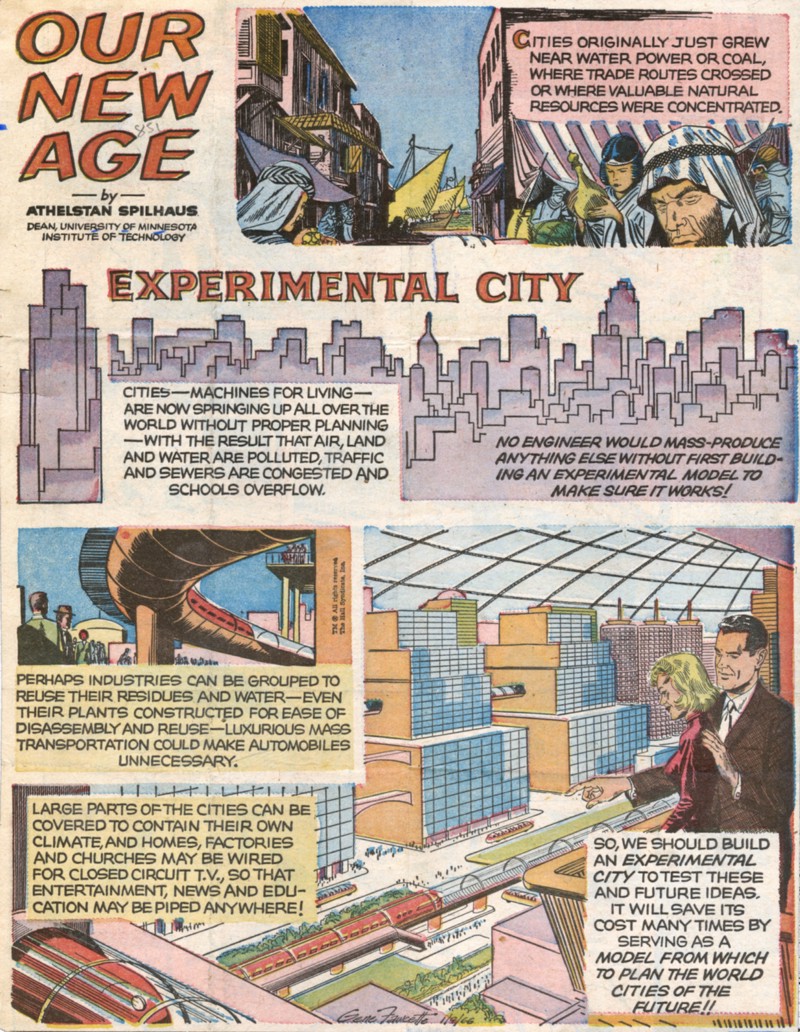

When New York City came close to bankruptcy in 1972, architect Peter Blake proposed that Walt Disney Productions should take over the city. As he wrote in New York Magazine, “the only new towns of any significance built in this country since World War II are Disneyland . . . and Disney World.” He wasn’t suggesting that the city be turned into a giant theme park, but instead referred to Disney’s visions for urban planning and implementation.
EPCOT, the Experimental Prototype Community of Tomorrow, was one of Walt Disney’s passion projects. Its plans were based on a radical design similar to Ebenezer Howard’s “Garden Cities of Tomorrow,” including a fully-pedestrianized central city with monorails running out from the central hub to suburban living spaces “like spokes from a wheel.”
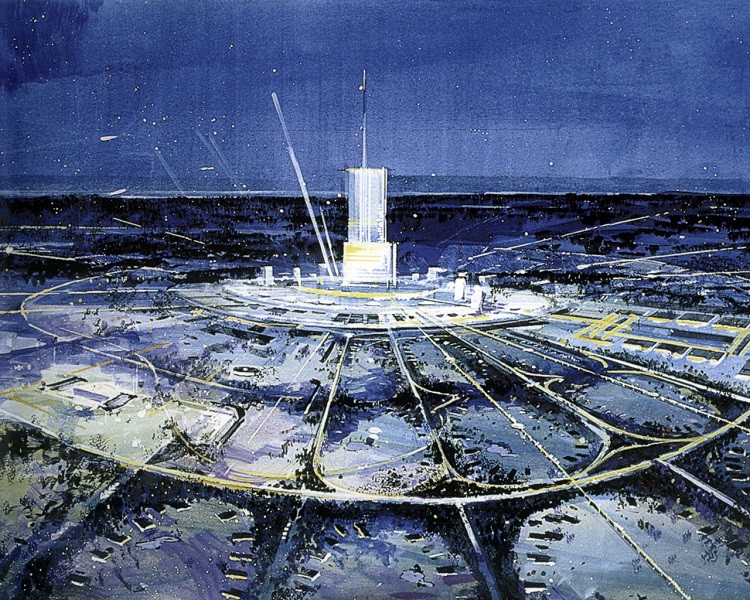
In October 1966, Disney presented his ideas about what he called “The Florida Project”–now better-known as Disney World–in a short film. He worked on EPCOT up to his death just two months later, but he would not see his dreams come to fruition. While EPCOT would never be built as it was originally envisioned, some ideas would be integrated into the park, especially in the EPCOT Center, opened in 1982.
Asked in an interview why people would come to EPCOT, friend of Disney and science fiction writer Ray Bradbury said:
“Because they want to look at the world of the future. They want to see how to make better human beings”¦.What Disney is doing is showing the world that there are alternative ways to do things that can make us all happy. If we can borrow some of the concepts of Disneyland and Disney World and EPCOT, then indeed the world can be a better place.”

On a smaller scale–financially, if not conceptually–the future of the city became a common theme for artists in advertising and periodicals over the 20th century. In 1931, Hugo Gernsback’s Science and Mechanics jumped forward 100 years to look at 21st-century New York City. The Empire State–the tallest building in the world until the construction of the World Trade Center towers in 1973–is dwarfed by the immense structures behind it, which come adorned with classical statues on a scale with the Colossus of Rhodes. Flying traffic fills the sky, while multi-laned roads crisscross buildings on multiple levels.

Frank Rudolph Paul, who created the cover, started out studying architecture. In a career tied closely to Gernsback’s, he became one of the period’s most popular pulp artists, producing the first cover for Amazing Stories, and the cover for Marvel Comics #1 in 1939.
In the 1920s, Greys Cigarettes produced a series of “anticipations,” taking a look at London 500 years in the future. Skyscrapers far taller than any of the period are linked by “moving pathways” under huge domes. “Suspended mono railways” supply transportation links, as do vehicles powered by atomic energy moving at “50, 100, 150, 200 MPH” on rubber roads. Small, intriguing details abound, like a monument stretching above the city dedicated to “The Heroes Of The Martian War.”
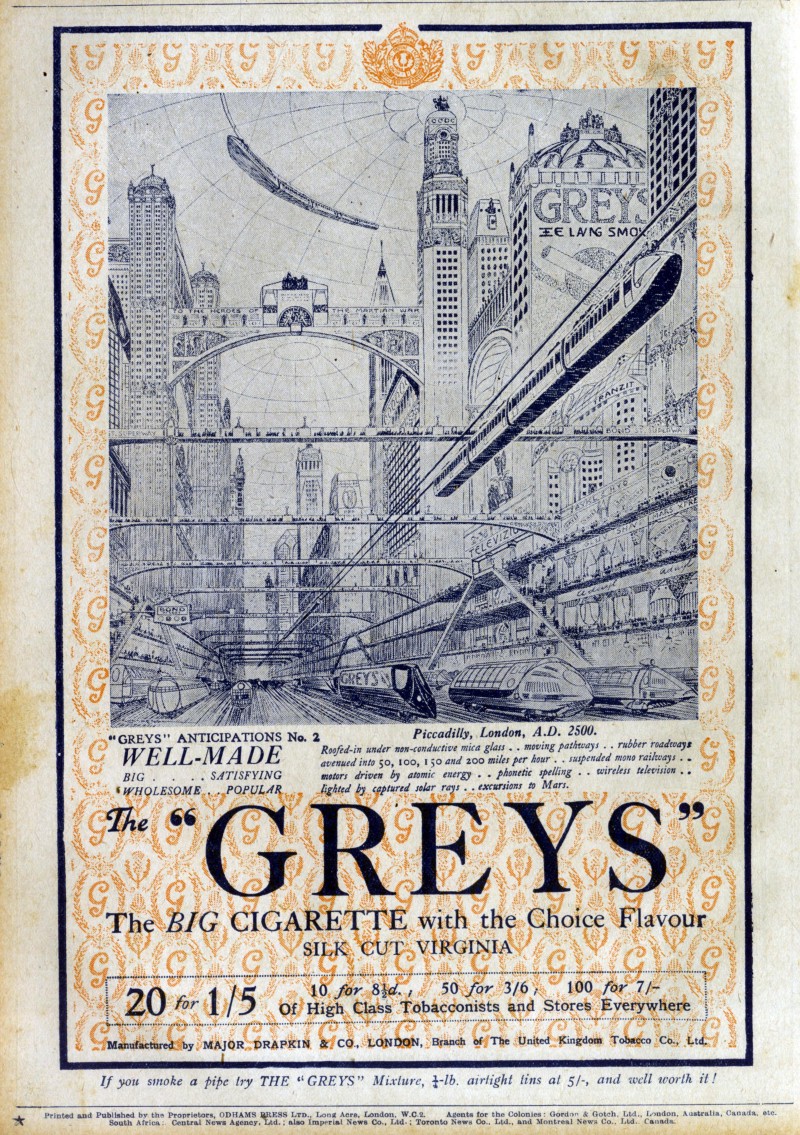
Weather-proof domes, a popular theme when depicting the cities of the future, also show up in Arthur Radebaugh’s “Closer Than We Think” comic strips. Atomic-powered cities under the ice caps, air-controlled glass-domed cities with moving walkways, and Megalopolis, a domed strip city that could conceivably run between Boston and Washington, D.C.
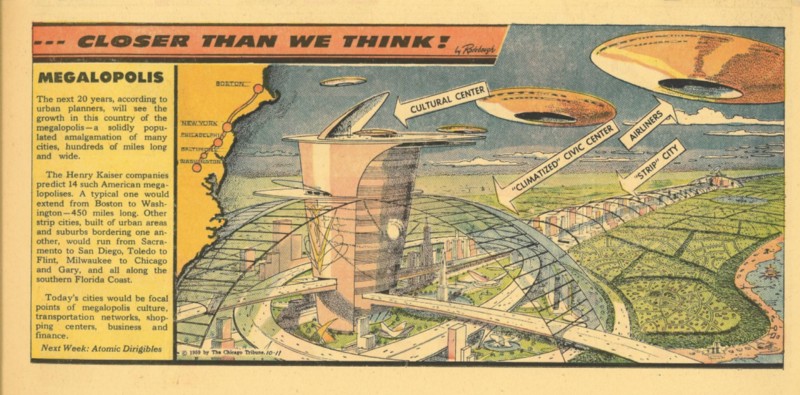
A 1934 image in Popular Science Monthly radically rethinks how we use both ground and airspace: bearing a strong resemblance to Soleri’s ziggurat-on-stilts concept, this future city is designed to solve the problem of skyscrapers blocking out the sun, with residents in the towers above given access to undiluted sunlight.
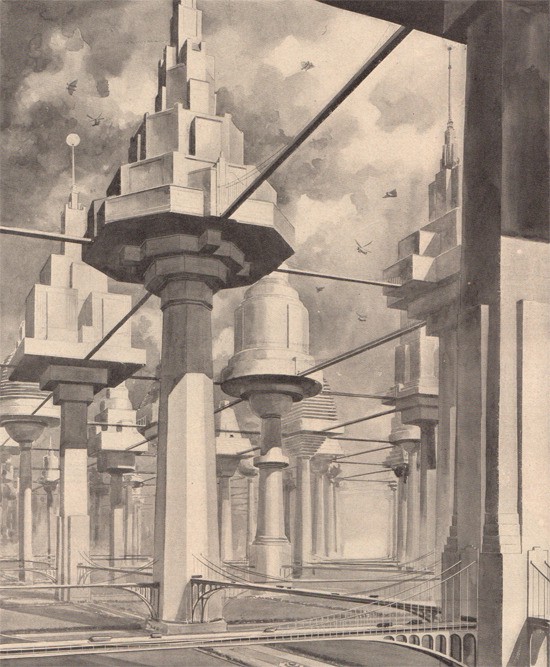
The only way isn’t always up. A “Depthscraper” inverts the skyscraper, a huge underground complex that theoretically “defies earthquakes.” Lighting for the 35 stories is provided by a series of prisms and a giant reflector tracking the sun, with fresh air pumped in from the surface.

And if land is finite, the solution to housing a growing population might not be building underground, but under the sea.




Keeping cities moving was an increasingly difficult problem: as populations grew, roads and sidewalks became more and more congested. Imagining future transport poses an interesting challenge for artists–and a perfect way to advertise building materials.
As city congestion grew, engineers from Bohn were on hand with a possible solution: since widening roads lined with skyscrapers would be too costly, why not simply go through them? These dizzyingly high roadways would be supported by structures built with Bohn’s “versatile metals.”
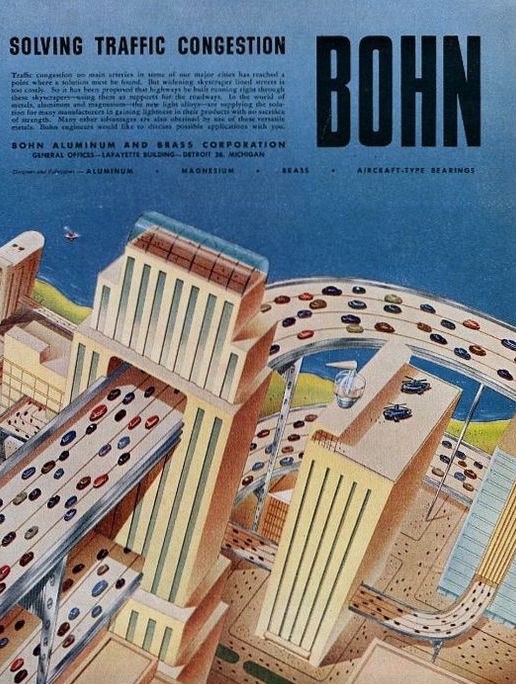
In a 1961 image that seems ahead of its time, Syd Mead’s take on a city highway for U.S. Steel shares the idea of color-coded roads with Disney’s “Magic Highway U.S.A.” It also seems to foreshadow ideas of a darker, more dystopian city–one he would eventually design when working on Blade Runner.
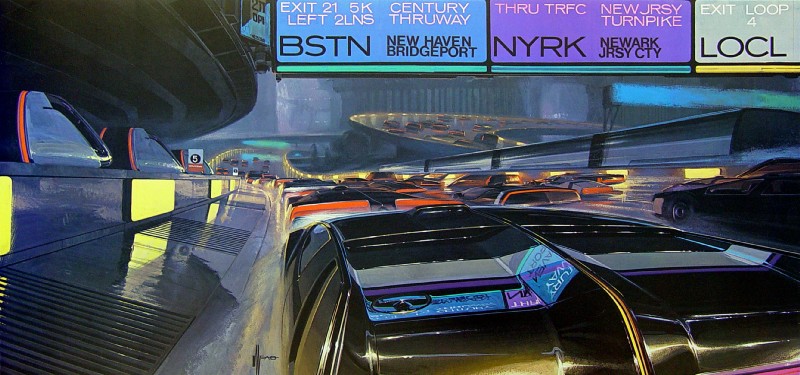
Artists didn’t leave pedestrians behind: “endless belt trains” would travel high above the city, and moving walkways were a frequently-imagined feature, such as in “Magic Highway U.S.A.”
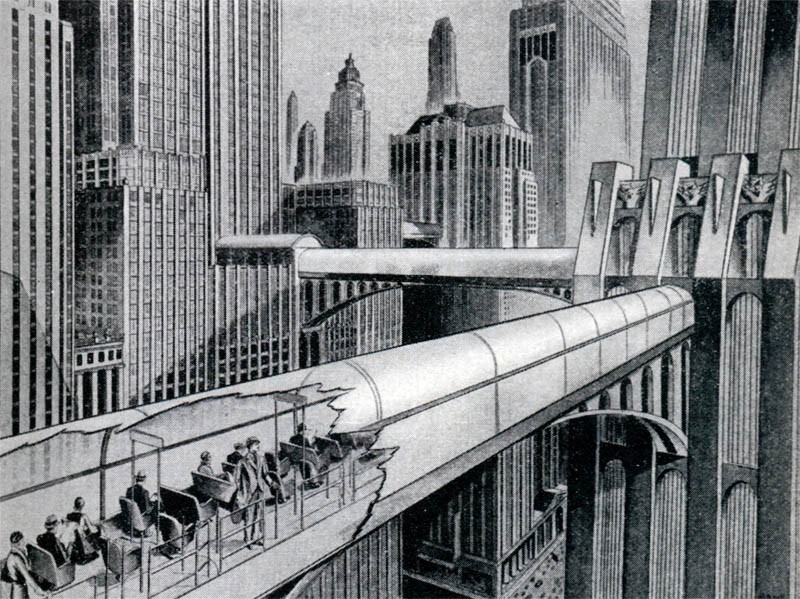

If cities could go underground, so could roads, with levels for slow traffic, fast traffic, and electric trains. The street level is vehicle-free, saved exclusively for the use of pedestrians.
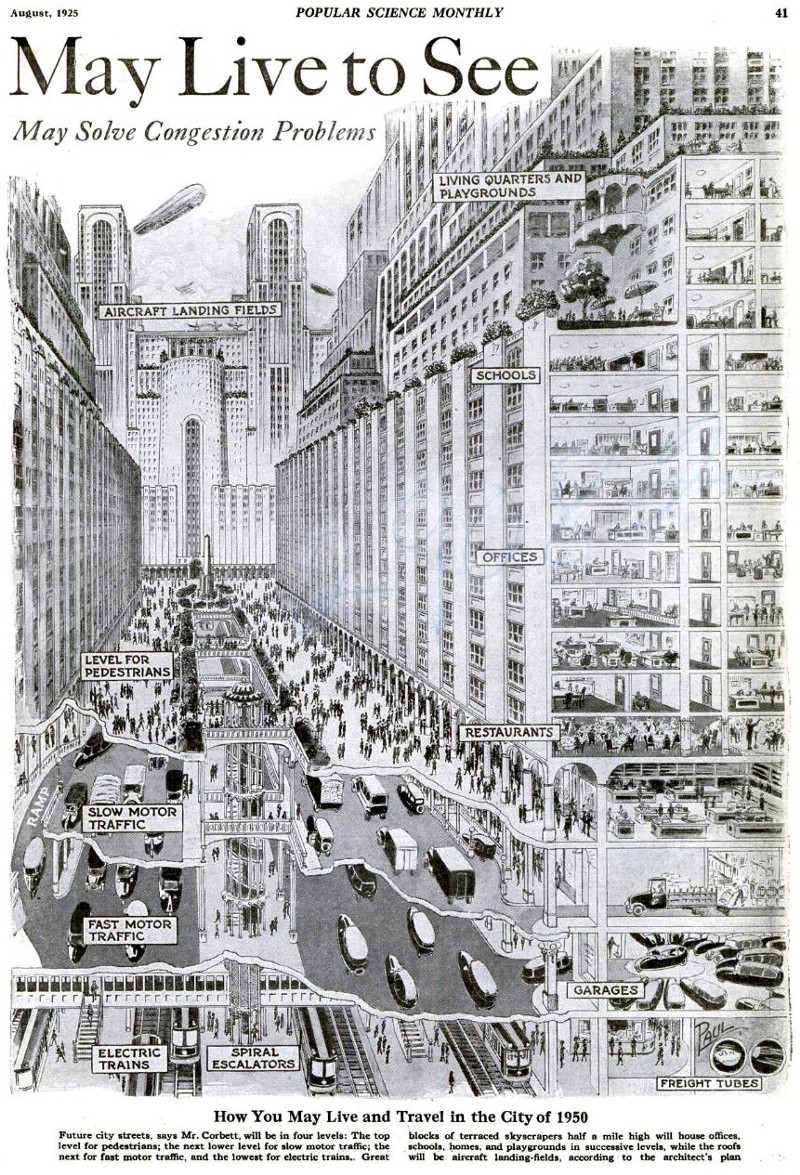
In the background, “aircraft landing fields” sit atop skyscrapers, something that would still be a feature in Frank R. Paul’s 1931 cover for Science and Mechanics, “A Hundred Years Hence.”
The skies of future cities had been full of flying vehicles since the 19th century. In 1939, an issue of Popular Science imagined our airborne transport in detail, with skyscrapers serving as airports and landing strips. Commuters would travel by private plane, taking elevators to a 250,000-space car park. Transport planes, blimps, and dirigibles bring travelers directly into the heart of the city. Once again, the Empire State Building is dwarfed by these futuristic structures.
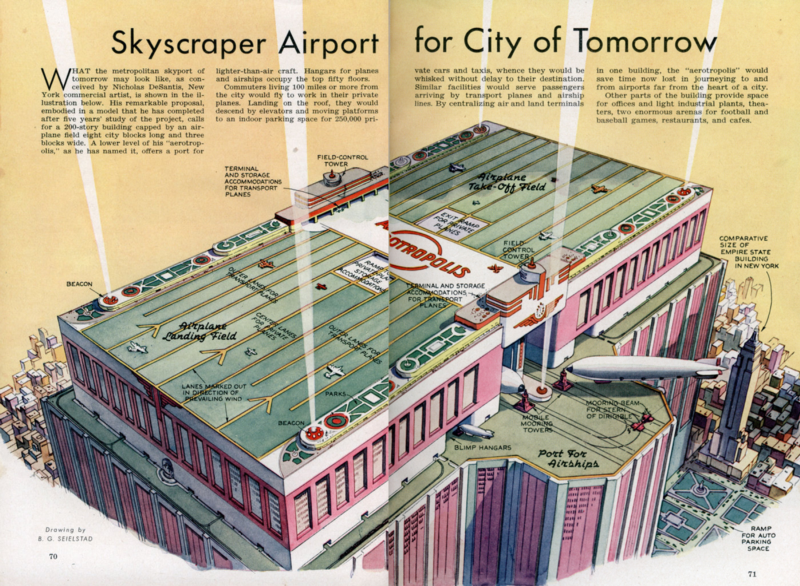

In the 1920s, the United States was enjoying an era of economic prosperity–and in the age of the skyscraper, the building industry was booming. Architects sought to make cities suitable for the needs of the 20th century, which lead to visionary design and ideas for radical urban change. Plans to redesign downtown Los Angeles and New York’s Lower East Side combined practical planning with the futuristic tropes present in magazines and advertising: towering buildings, sunken roads, multi-layered walkways, rooftop helipads, and aircraft landing strips.

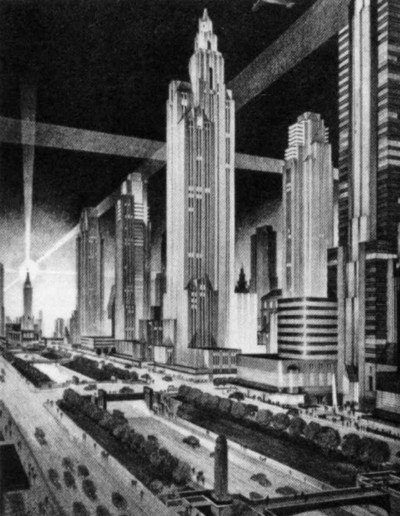
As buildings grew higher, sunlight was a consistent problem. Worried that ever-rising skyscrapers would lead to gloomy streets in permanent shadow, New York passed the 1916 City Zoning Resolution, the first law of its kind in the U.S.
Architect Harvey Wiley Corbett recruited artist Hugh Ferriss to visualize what the law would mean for New York’s buildings. Ferriss bridged the worlds of illustration and architecture: as an illustrator, he was employed by advertising agencies and publications, but when working with architects, his skills were used to render building plans into three-dimensional concept pieces using his distinctive and dramatic style.
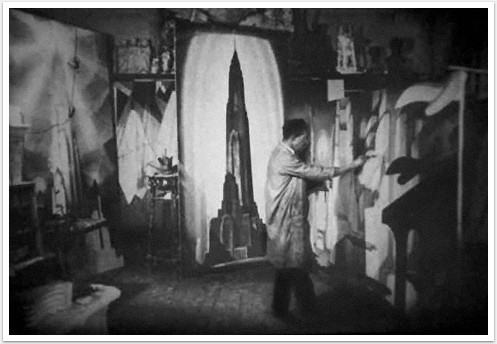
Some of the ideas from his collaboration with Corbett were collected in the 1929 book The Metropolis of Tomorrow. In the third section, “An Imaginary Metropolis,” Ferriss shows plans for an entire city that showcases not only his draughtsmanship, but his forward-looking ideas on urban planning. Like Disney’s EPCOT, Ferriss echoed Ebenezer Howard’s concept in “Garden Cities of Tomorrow,” with a central spoked wheel and open spaces between buildings, allowing light through and the streets below to breathe.

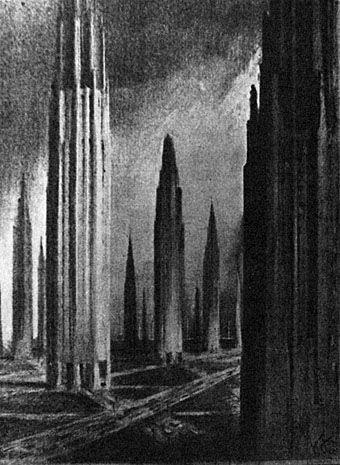
The circular city in “An Imaginary Metropolis” is designed around specific zones for business, science, and art. Key buildings in these immense structures loom over roads and city blocks; the Art Center creates a formidable presence, resembling a sequence of ziggurats.
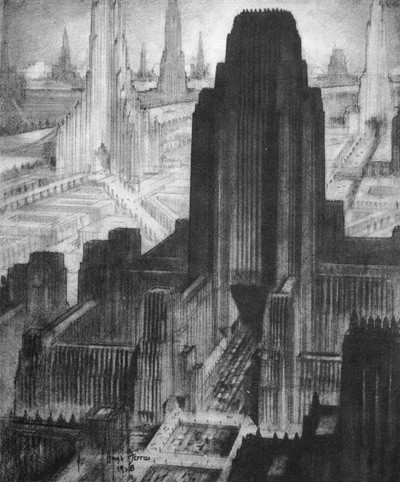
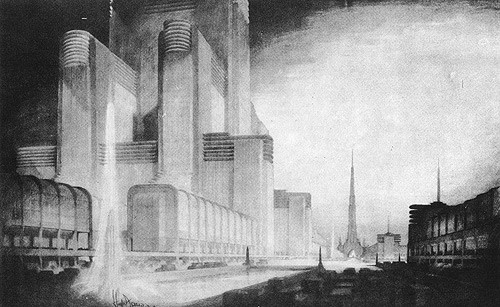

Living spaces are created with innovative uses of the space, building immense residential structures into bridges that straddle rivers and the highway alike.
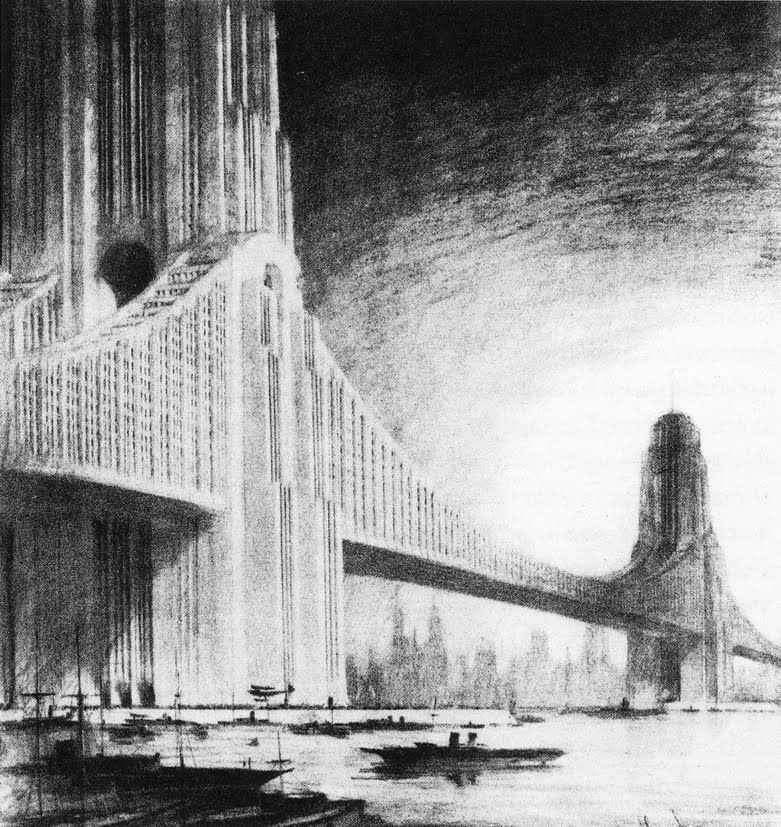
Ferriss later expanded on the work of The Metropolis of Tomorrow, with highways passing through buildings at numerous levels to keep traffic in the the city flowing. In a dramatic 1930 image, a plane zooms overhead while a lone figure surveys the walkways and roads that criss-cross below from a perch on a skyscraper aircraft hanger.
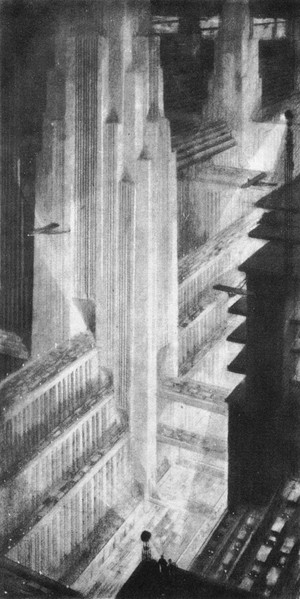
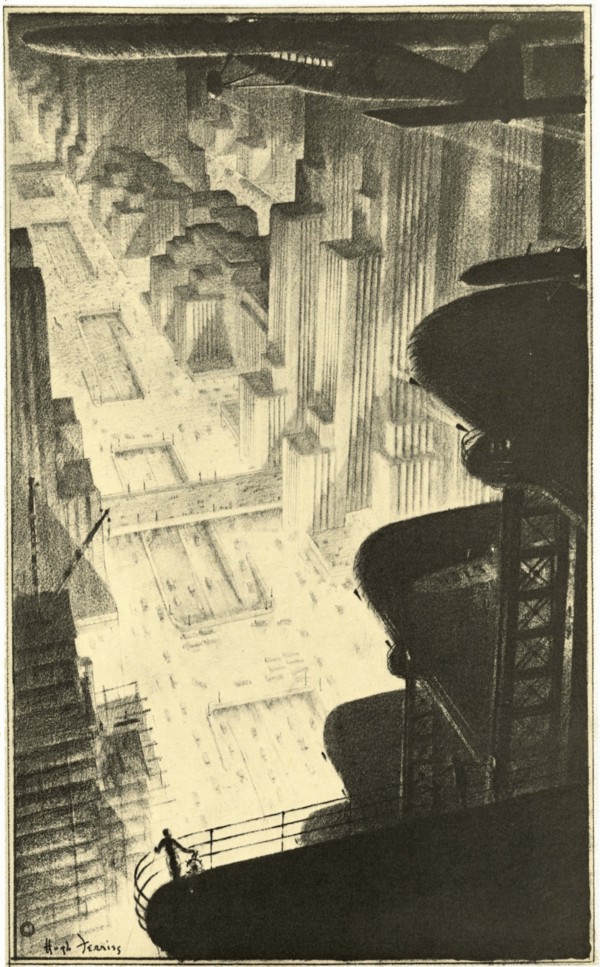
Ferriss’s images transcend architectural rendering: his dramatic sense of light and shadow depict cities strangely devoid of people, or solo figures dwarfed by their majestic surroundings. His influence can be seen in fictional cities throughout the 20th century. Anton Furst’s designs for Gotham City in 1989’s Batman inverts Ferriss’ utopia as corrupted decaying failure. The entire aesthetic of 2004’s Sky Captain and the World of Tomorrow could have come directly from the mind of Ferriss himself. It is also possible Ferriss himself was influenced by film, considering the similarities between his vision and the city depicted in 1927’s Metropolis.
But despite the beauty, there are few details on how his The Metropolis of Tomorrow might work, were it to become a reality. And in 1929, the stock-market crash brought an end to the building boom–and an end to many ambitious plans.

How do grand visions meet reality? Fantastical ideas for future cities have found more practical champions: in a speech at Harvard University included in the original EPCOT pitch film, urban planner James W. Rouse said, “I hold a view that may be somewhat shocking to an audience as sophisticated as this: that the greatest piece of urban design in the United States today is Disneyland.”
Disneyland, while made from bricks and mortar, is still a fantasy. The idea that Disney could somehow solve real problems in an established complex city like New York seems a fantasy as well. Many artists who dreamed up visions of the future favored massive, impressive schemes over the more incremental, less glamorous solutions of city planners. If these visions could never be implemented, what purpose do they serve?
Whether or not ideas like the original plan for EPCOT or “An Imaginary Metropolis” are feasible, it may be irrelevant. Instead they offer us a fantastical mirror–places free from the real-world problems our cities face, like poor planning, uncontrolled sprawl, and social inequality. They offer an ideal to strive for, and at the very least they are a love letter to the idea of the city–and many of them we can now inhabit, if only in fiction, films, and computer games. Spaces where–unhampered by the realities of money and bureaucracy–the Metropolis of Tomorrow can thrive.

Read the next installment: “The Future We Were Promised”
Read the previous installment: “Animating the Future“

How We Get To Next was a magazine that explored the future of science, technology, and culture from 2014 to 2019. A Visual History of the Future is a five-part series on the way artists’ visions of the future shaped the world we now know.
